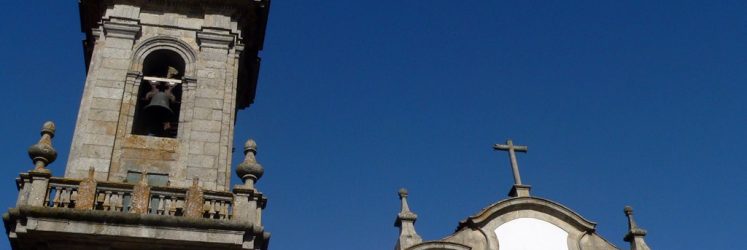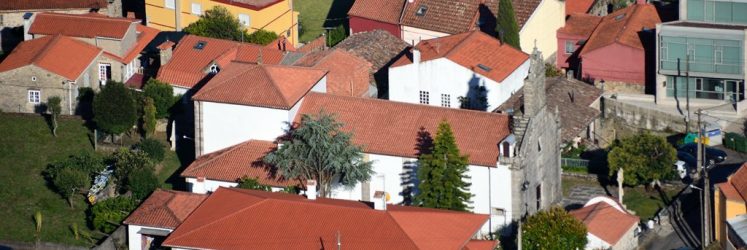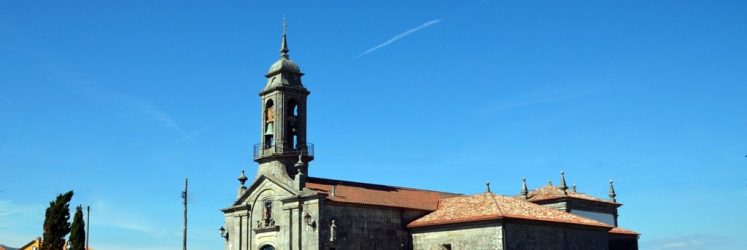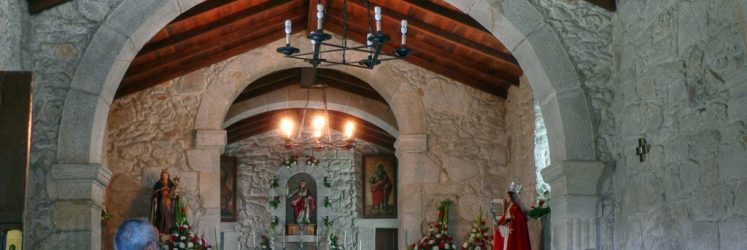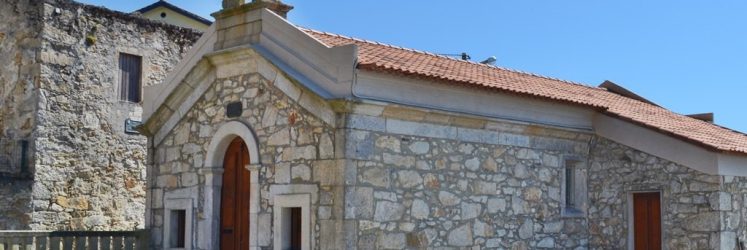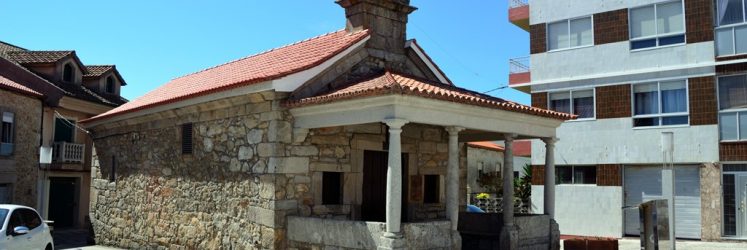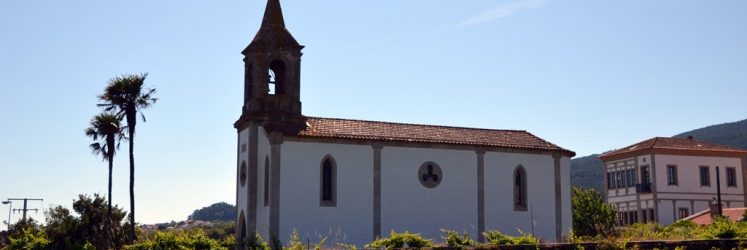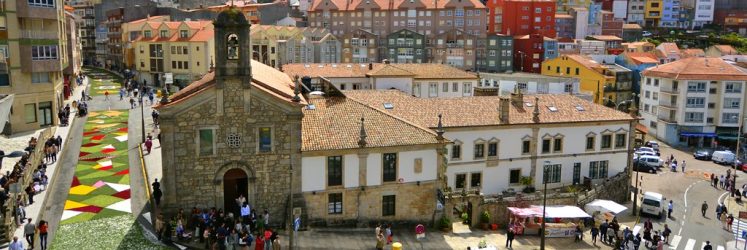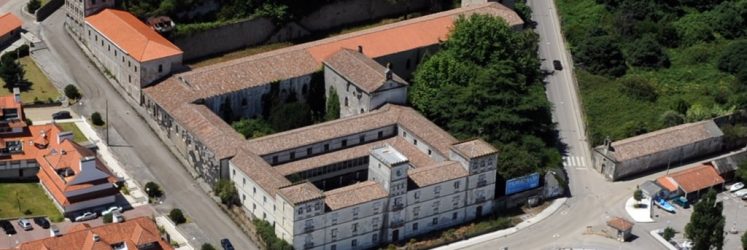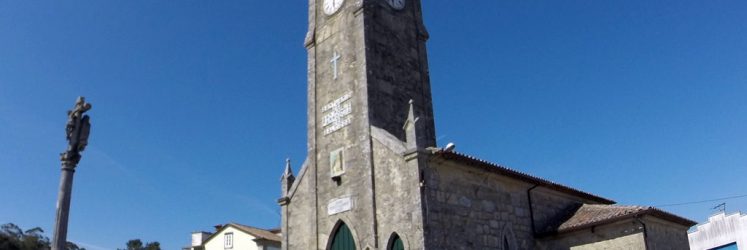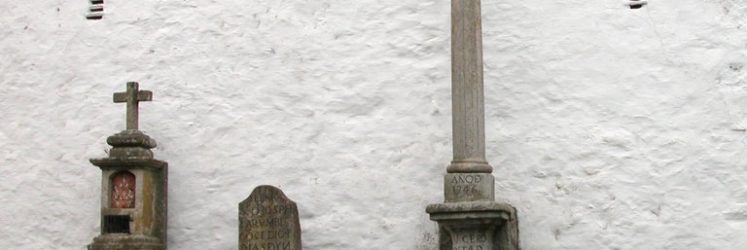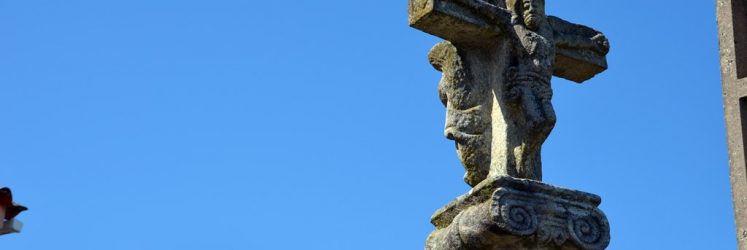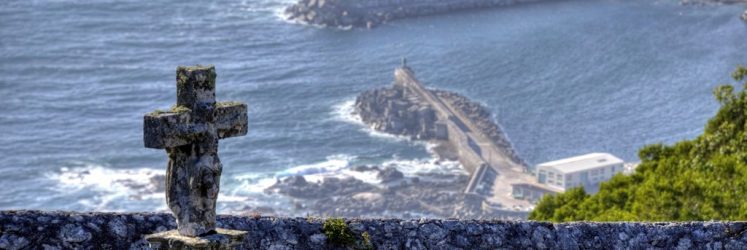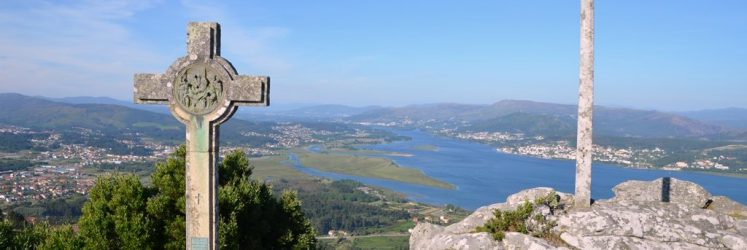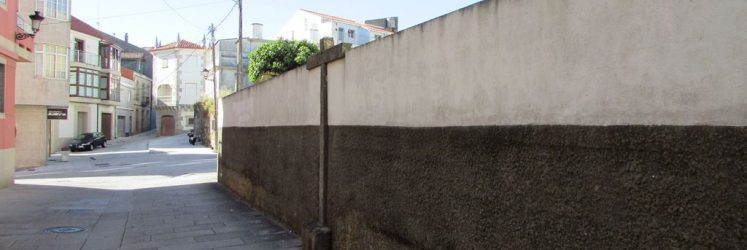titulo
PARISH CHURCH OF ST. MARY IN A GUARDA
The parish church initially Romanesque was expanded in the 16th century when Diego de Torquemada was the bishop of Tui. At the interior stands out the retable of the high altar, from the 18th century in Borrominiesque style and dedicated to the Assumption of the Virgin Mary.
Of keen interest is the statues of Christ: Christ Lying, a local sculptor Cándido Sobrino work; in the retable of the Altar of the Anima had placed the Crucified Christ, according to tradition this statue was recovered from the sea after was thrown by the British Catholics in Henry VIII age.
The main façade is in Baroque style with white walls (Portuguese influenced), and the south façade is of Renaissance style. The side tower has a rectangular plan, and it was topped with a dome in the 19th century.
PARISH CHURCH OF THE VISITATION IN CAMPOSANCOS
This church was built in the early 20th century over the ancient chapel consecrated to San Mauro in the site known as Church Plaza. In the middle of the 19th century started the works at the same time as the old chapel of San Telmo was opened in the Saa neighbourhood. In front of the church is located the new cruceiro (stone cross) of San Amaro with the image of St. Elizabeth at the rear.
PARISH CHURCH OF SAN LORENZO IN SALCIDOS
The building was promoted by the parish priest Álvaro, from the distinguished family Ozores de Sotomayor, in the 16th century, though only the interior structure is conserved. In 1760 was erected the chancel.
HERMITAGE OF SANTA TREGA
At the top of the mountain, in the San Francisco peak, is located the chapel or hermitage of Santa Trega. The worship of the saint from Iconium are dated back to the 7th century. Probably the nun Egeria after to come back of her pilgrimage to Orient, encouraged the devotion for Saint Thecla local hermits.
The existence of a hermitage is already recorded since the 12th century; it was with the renovations and enlargements at the 16th and 17th centuries that attained its current appearance. The archaeological excavations made in 1994 around the chapel, led to the discovery of several Visigoth’s sepulchres that showed the religiosity of the place. Sign of the critical religious tradition and the worship of Santa Trega are the various religious festivities.
CHAPEL OF SAN CAETANO
Built in the 17th century in a strategic location of the A Cruzada neighbourhood, very useful to indicate the coastline to the navigators. The bell was a present from a British ship that in 1735 prevented its sinking when they sighted the chapel.
The A Cruzada neighbourhood jutting out above the sea level and the plaza in front of the chapel becomes an excellent viewpoint to get a sight up of the coastline of A Guarda, the boats arriving at the port, etc. The view of the winter storms is fantastic from here.
CHAPEL OF LA GUIA
The chapel dated from the 16th century and is consecrated to the Virgin of La Guía (could be translated as “the adviser or guide”) with a strong devotion between the fishermen. It is a small size building, and it has a cantilever deck by way of a porch. The chapel placed in the high neighbourhood called Ribadavila (“upon the village”) that is extramural of the medieval town. It was customary the square was the passage place for merchants and traders towards Baiona.
CHAPEL OF LAS MERCEDES
It was a fulfilled wish of the presbyter Severino Álvarez Otero, to raise a chapel consecrated to the Virgin of the Mercy in the A Gándara neighbourhood (parish of Salcidos) where he was born. He develops his religious work in the American continent where he fundraised the money to build the chapel. In 1918 it was opened coinciding with the festivity of the Virgin of Mercy.
CONVENT OF SAN BENITO
Founded in the 16th century by the Ozores de Sotomayor family. The nuns left their house in 1983, and after a renovation, it turned into a hotel and a restaurant. The church, small and spoiled, was rebuilt in the 17th century and it is still in use for the religious cult. In the side façade in baroque style are located the family blazon and the one of the Saint Benedict order.
ANCIENT SCHOOL OF THE JESUITS
In the O Pasaxe neighbourhood, at the parish of Camposancos, is located the ancient School of the Jesuits, acquired by the Order became shortly into the bigger in Spain in the Company possession. Besides it was the headquarter of the University School for eight years (1877-1885), the seed of the University of Deusto.
SANCTUARY OF SAN ROQUE
In neo-gothic style, built in 1914, replaced the old 17th-century chapel. In front of the façade is erected an 18th-century artistic cruceiro (stone cross).
CRUCEIRO PINTO & PETO DAS ANIMAS
At the parish of Salcidos, we find this great set composed of three elements: the cruceiro (stone cross), a peto das animas (alms box) and a stele. The ensemble was made between 1746 and 1764. Above the base upraises a column topped with the capital decorated with acanthus leaves, on top Christ crucified on the Cross and Saint Francis in the attitude of prayer on the left.
CRUCEIRO OF A PROBA
Cruceiro (stone cross) of 1696, its shaft is square base and turning into cylindrical and fluted while ascends. The Ionic capital is quite simple but shows the image of Crucified on the backside and a Virgin of Sorrow at front with Child in her arms. Near we find a peto das animas (alms box) embedded in a wall.
CRUCEIRO OF A CAL
Slender and well-proportioned cruceiro (stone cross) of mid 18th century which stands out artistically due to religious images of the Cross.
CRUCEIRO OF SAN FRANCISCO
In front of the hermitage of Santa Trega is located the Cruceiro of San Francisco that remembers the presence of the Franciscans in the region. These monks lived in A Insua, the small Portuguese island just at the confluence of the river and the sea. This cruceiro dated in the 16th century displays a Christ on the front and a figure of Saint Francis of Assisi on the backside.
CRUCEIRO OF O COUTO
At the O Couto neighbourhood (parish of Camposancos) this noticeable cruceiro (stone cross) of the late 19th century and early 20th. On a well-worked base is raised the fluted shaft finished with an ornamented capital with acanthus leaves and scrolls, on the top, the cross with square arms, reinforced on the terminals with quadrangular mouldings.
The Christ image is out of proportion in some details as the wound on the thorax or the bleeding knees. At his feet the traditional skull and one kneeling angel on each side.
VIA CRUCIS OF THE SANTA TREGA MOUNTAIN
The most artistic Via Crucis (Way of the Cross) was conceived by the Society Pro Monte in the 20’s to replace the old one, made in a simple style and dated in the 16th-17th centuries. The sculptor from Valencia Julio Vincent y Mengual designed these substantial artistic crosses, where were embedded circular low-reliefs worked in bronze to illustrate the stations of the way.
VIA CRUCIS OF THE CALVARIO STREET
The Way of the Cross goes along the Calvario Street until the Chapel of La Guía. This street is popularly known as the street of the “Cordoería” an allusion to an ancient ropes factory set there.




